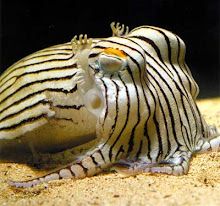YOU'RE a nudibranch!




 selected quotes on cuttlefish:
selected quotes on cuttlefish:Did you know that cuttlefish have blue blood?
Did you know that cuttlefish have three hearts?
Did you know that cuttlefish are considered to be highly intelligent animals that possess excellent touch, smell and visual abilities?
From its coloring and the way it moves it looks like a large nudibranch (? ha!). It actually seems to walk on two of its larger tentacles. The stripes on its back pulse from white to yellow to brown and violet
The cuttlefish is an ambush predator and a master of disguise (like me). Its skin is covered with special cells called chromatophores, iridophores and leucophores that reflect light in many different colours enabling the cuttlefish to blend into its background almost perfectly. Some say it's like a chameleon but it is far superior in its ability to change colour and even the texture of its skin!
Cuttlefish ink times ago was used to colour photographs (sepia colour). Cuttlebones are used as calcium supplements for pet birds and for polishing silver (when powdered)
Cuttlefish eyes are among the most developed in the animal kingdom. They have similar eyes to humans, but the pupil is a smoothly-curving "w" shape.
Our conclusion in non-scientific terms is that they are as intelligent as dogs.
More often than I can explain by chance, they’ve appeared on the reef, as a calming presence when I’ve gone into the ocean because I’m in conflict with something or someone and I need to clear my head. It’s as if they are saying “Chill out. Let’s play chase across the reef.” And that’s exactly what I do.
Cuttlefish blends superbly with its surroundings by curling its arms and sprouting spiky skin projections, called papillae, in imitation of the surrounding seaweed, rock or coral and changing color in less than a second – faster than any other animal. To compare the chameleon (lizard) takes just under 2 minutes. Both skin texture and color changes are directly controlled by the animal’s brain. Messages enter the brain through the eye via the optic nerve and are then sent straight to the chromatophores (pigment cells).
Researchers have shown that cuttle fish use these color changes as a way to communicate. They have identified over 50 "words" which cuttle fish use
One cuttlefish came forward out of the crowd to meet each of us. Mike had a cuttlefish. I had a cuttlefish. Megaera had a cuttlefish. And Malachi, who is the smallest of us, had a small cuttlefish. We gestured at them and they gestured at us. "What's he saying? What's he saying?" Malachi kept asking. Malachi's cuttlefish didn't do much gesturing. It just stared at Malachi, and we had the impression that it was another child, staring like a toddler with its mouth hanging open. Another tourist saw what we were doing, and joined us. Another cuttlefish came forward to meet her. After a moment, she darted all her fingers at it suddenly, and it jumped back. It slowly came forward to face her again. Then it shot its syphon out at her. She squealed and leapt back. Mike's cuttlefish then shot its syphon out at Mike a few times. Mike answered by flicking his fingers at the cuttlefish. Neither of them jumped.
In aquaria, they have even made attempts at imitating chess boards! From the moment of hatching, young cuttlefish can display at least 13 types of body pattern, made up from more than 30 different components.
Groups of up to seven huge males battle with each other using intense blasts of colour until one emerges as the winner. He then turns his attentions to the smaller females, mesmerizing them with another kaleidoscopic display.
Their intelligence and charisma often make it hard for scientists to think of them objectively as research animals instead of as pets.
Among their range of unusual sexual antics is “sneaky sex”, where the physically smaller males, who can’t compete with larger males, “cross-dress”. The smaller males change body colour and trick the stronger males into thinking they’re females. When the strong males are not looking, the smaller males change colour again and quickly mate with the females.


0 Comments:
Post a Comment
<< Home